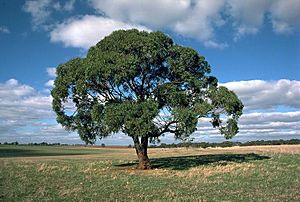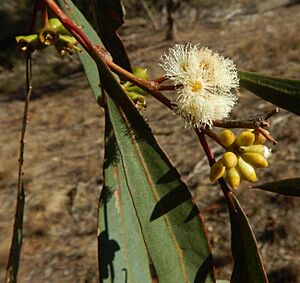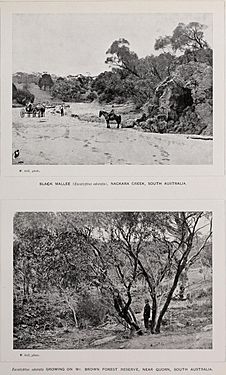Peppermint box facts for kids
Quick facts for kids Peppermint box |
|
|---|---|
 |
|
| Eucalyptus odorata near Gawler | |
| Scientific classification | |
| Genus: |
Eucalyptus
|
| Species: |
odorata
|
| Synonyms | |
|
|
The Eucalyptus odorata, often called peppermint box, is a special kind of mallee or a small tree. It grows only in South Australia. This tree has rough, tough bark on its main trunk and bigger branches. Its thinner branches have smooth, grey bark. You can spot it by its spear-shaped adult leaves, flower buds that grow in groups, white flowers, and fruit shaped like a cylinder or barrel.
Contents
About the Peppermint Box Tree
The peppermint box is a mallee or a small tree. It usually grows to be about 2–12 m (6 ft 7 in – 39 ft 4 in) (6.5 to 39 feet) tall. It has a special woody swelling at its base called a lignotuber. This helps the tree regrow if it gets damaged, like by a bushfire.
What the Bark Looks Like
The bark on the main trunk and larger branches (thicker than 50–100 mm (2.0–3.9 in) or 2-4 inches) is rough, hard, and has cracks. The bark on the thinner branches is smooth and can be grey or brownish.
Leaves and Flowers
- Young Leaves: When the plant is young, or when new shoots grow from the base (called coppice regrowth), the leaves are spear-shaped. They are about 40–105 mm (1.6–4.1 in) (1.5-4 inches) long and 4–23 mm (0.16–0.91 in) (0.15-0.9 inches) wide.
- Adult Leaves: Mature leaves are glossy green on both sides. They are also spear-shaped, measuring 55–140 mm (2.2–5.5 in) (2-5.5 inches) long and 6–20 mm (0.24–0.79 in) (0.2-0.8 inches) wide. They narrow down to a stalk, called a petiole, which is about 5–15 mm (0.20–0.59 in) (0.2-0.6 inches) long.
- Flower Buds: The flower buds grow in the angle where a leaf meets the stem (called a leaf axil). They appear in groups of seven, nine, or eleven on a single stalk called a peduncle. Some buds are attached directly without a stalk (called sessile), while others have small stalks (called pedicels) up to 6 mm (0.24 in) (0.2 inches) long.
- Mature Buds: When the buds are ready to open, they are shaped like a spindle or an oval. They are 4–8 mm (0.16–0.31 in) (0.15-0.3 inches) long and 2–4 mm (0.079–0.157 in) (0.08-0.15 inches) wide. They have a cap, called an operculum, which can be cone-shaped or have a beak-like tip.
- Flowering Time: Peppermint box trees usually bloom between March and October. Their flowers are white.
- Fruit: After flowering, the tree produces a woody fruit. This fruit is a capsule shaped like a cylinder or a barrel. It's about 4–8 mm (0.16–0.31 in) (0.15-0.3 inches) long and 4–7 mm (0.16–0.28 in) (0.15-0.27 inches) wide. The parts that open to release seeds (called valves) are close to the rim of the fruit.
Naming the Peppermint Box
The scientific name Eucalyptus odorata was first officially described in 1847. This was done by a scientist named Hans Hermann Behr in a journal called Linnaea.
The second part of its scientific name, odorata, comes from the Latin word odoratus. This word means "having a smell." It refers to how the leaves smell when you crush them.
Where Does Peppermint Box Grow?
The peppermint box tree is found in many places across South Australia. You can see it between the southern Flinders Ranges and towns like Bordertown and near Lake Alexandrina. It also grows on the lower Eyre Peninsula and Kangaroo Island.
Sometimes, it can also be found in north-western Victoria. There are even a few records of it growing in the Cobar area of New South Wales. This tree can grow in different types of places, but it's most common on rolling hills.
Gallery
- Illustration/Historical Images
These images come from "The Forest Flora of New South Wales" (1913) by J.H Maiden. He was a government botanist and director of the Botanical Gardens in Sydney. This book was published between 1902 and 1925 and is now in the public domain, meaning anyone can use these images freely.





